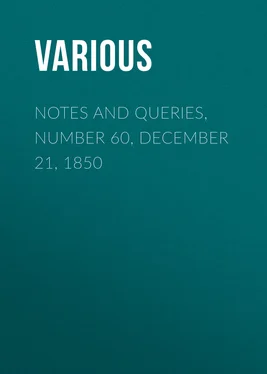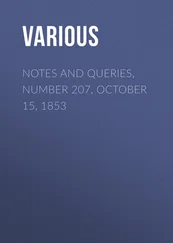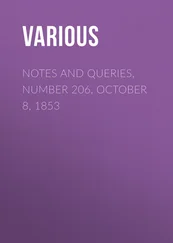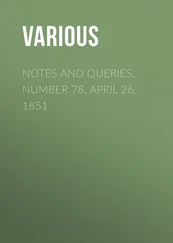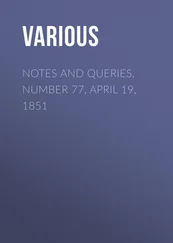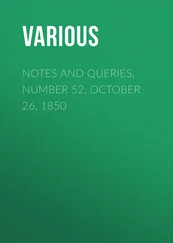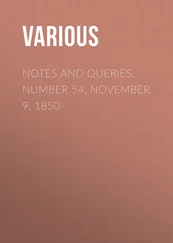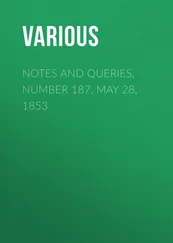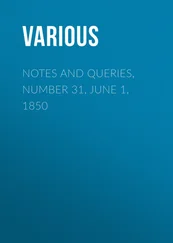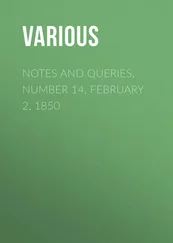Various - Notes and Queries, Number 60, December 21, 1850
Здесь есть возможность читать онлайн «Various - Notes and Queries, Number 60, December 21, 1850» — ознакомительный отрывок электронной книги совершенно бесплатно, а после прочтения отрывка купить полную версию. В некоторых случаях можно слушать аудио, скачать через торрент в формате fb2 и присутствует краткое содержание. Жанр: foreign_antique, periodic, foreign_edu, на английском языке. Описание произведения, (предисловие) а так же отзывы посетителей доступны на портале библиотеки ЛибКат.
- Название:Notes and Queries, Number 60, December 21, 1850
- Автор:
- Жанр:
- Год:неизвестен
- ISBN:нет данных
- Рейтинг книги:5 / 5. Голосов: 1
-
Избранное:Добавить в избранное
- Отзывы:
-
Ваша оценка:
- 100
- 1
- 2
- 3
- 4
- 5
Notes and Queries, Number 60, December 21, 1850: краткое содержание, описание и аннотация
Предлагаем к чтению аннотацию, описание, краткое содержание или предисловие (зависит от того, что написал сам автор книги «Notes and Queries, Number 60, December 21, 1850»). Если вы не нашли необходимую информацию о книге — напишите в комментариях, мы постараемся отыскать её.
Notes and Queries, Number 60, December 21, 1850 — читать онлайн ознакомительный отрывок
Ниже представлен текст книги, разбитый по страницам. Система сохранения места последней прочитанной страницы, позволяет с удобством читать онлайн бесплатно книгу «Notes and Queries, Number 60, December 21, 1850», без необходимости каждый раз заново искать на чём Вы остановились. Поставьте закладку, и сможете в любой момент перейти на страницу, на которой закончили чтение.
Интервал:
Закладка:
Again I say, why not print the work?
J.M.[We have reason to believe that this important historical document is about to be printed.]
PARALLEL PASSAGES
In Shakspeare's Henry IV. , Act V. Sc. 4., the Prince exclaims, beholding Percy's corpse,—
"When that this body did contain a spirit,
A kingdom for it was too small a bound;
But now two paces of the vilest earth
Is room enough!"
In Ovid we find the following parallel:—
"… jacet ecce Tibullus,
Vix manet e toto parva quod urna capit."
A second one appears in the pretended lines on the sepulchre of Scipio Africanus:—
"Cui non Europa, non obstitit Africa unquam,
Respiceres hominem, quem brevis urna premit."
The same reflection we find in Ossian:—
"With three steps I measure thy grave,
O thou, so great heretofore!"
It is very difficult indeed to determine in which of these passages the leading thought is expressed best, in which is to be found the most energy, the deepest feeling, the most touching shortness. I think one should prefer the passage of Shakspeare, because the direct mention of the corporal existence gives a magnificent liveliness to the picture, and because the very contrast of the space appears most lively by it; whereas, at the first reading of the other passages, it is not the human being, consisting of body and soul, which comes in our mind, but only the human spirit, of which we know already that it cannot be buried in the grave.
One of the most eminent modern authors seems to have imitated the passage of Shakspeare's Henry IV . Schiller, in his Jungfrau von Orleans , says:—
"Und von dem mächt'gen Talbot, der die Welt
Mit seinem Kriegeruhm füllte, bleibet nichts
Als eine Hand voll leichten Staubs."
(And of the mighty Talbot, whose warlike
Glory fill'd the world, nothing remains
But a handful of light dust.)
Berlin.
Minor Notes
True or False Papal Bulls .—
"Utrum bulla papalis sit vera an non.
"Si vis scire utrum literæ domini Papæ sint veraces vel non, numera punctos quæ sunt in bulla. Et si inveneris circulum ubi sunt capita apostolorum habentem 73 punctos, alium vero circulum 46, alium super caput Beati Petri habentem 26, alium super caput Sancti Pauli habentem 25 punctos, et punctos quæ sunt in barbâ 26, veraces sunt; alioquin falsæ.—Sir Matthew Hale's Manuscripts , Library of Lincoln's Inn, vol. lxxiii. p. 176.
To which may be added, that in digging for the foundations of the new (or present) London Bridge, an instrument was dug up for counterfeiting the seals or Bullæ? Where is it now deposited?
J.E.Burning Bush of Sinai. —
"Pococke asserts that the monks have planted in their garden a bush similar to those which grow in Europe, and that by the most ridiculous imposture, they hesitate not to affirm that it is the same which Moses saw—the miraculous bush. The assertion is false, and the alleged fact a mere invention."—Geramb's Pilgrimage to Palestine, &c. , English trans.
March 1. 1847. The bush was exhibited by two of the monks at the back of the eastern apse of the church, but having its root within the walls of the chapel of the burning bush. It was the common English bramble, not more than two years old, and in a very sickly state, as the monks allowed the leaves to be plucked by the English party then in the convent. The plant grows on the mountain, and therefore could be easily replaced.
Viator.The Crocodile (Vol. ii., p. 277.).—February, 1847, a small crocodile was seen in the channel, between the island of Rhoda and the right bank of the Nile.
Viator.Umbrella. —It was introduced at Bristol about 1780. A lady, now eighty-three years of age, remembers its first appearance, which occasioned a great sensation. Its colour was red, and it probably came from Leghorn, with which place Bristol at that time maintained a great trade. Leghorn has been called Bristol on a visit to Italy.
Viator.Rollin's Ancient History, and History of the Arts and Sciences. —Your correspondent Iota inquires (Vol. ii., p. 357.), "How comes it that the editions" (of Rollin) "since 1740 have been so castrated?" i.e. divested of an integral portion of the work, the History of the Arts and Sciences . It is not easy to state how this has come to pass. During the last century comparatively little interest was felt in the subjects embraced in the History of the Arts and Sciences ; and probably the publishers might on that account omit this portion, with the view of making the book cheaper and more saleable. It is more difficult to assign any reason why Rollin's Prefaces to the various sections of his History should have been mutilated and manufactured into a general Introduction or Preface, to make up which the whole of chap. iii. book x. was also taken out of its proper place and order. A more remarkable instance of merciless distortion of an author's labours is not to be found in the records of literature. Iota may take it as a fact—and that a remarkable one—that since 1740 there had appeared no edition of Rollin having any claim to integrity, until the one edited by Bell, and published by Blackie, in 1826, and reissued in 1837.
Veritas.Glasgow, Dec. 7. 1850.
MSS. of Locke. —E.A. Sandford, Esq., of Nynehead, near Taunton, has a number of valuable letters, and other papers, of Locke, and also an original MS. of his Treatise on Education . Locke was much at Chipley in that neighbourhood, for the possessor of which this treatise was, I believe composed.
W.C. Trevelyan.The Letter ⌧.—Dr. Todd, in his Apology for the Lollards , published by the Camden Society, alludes to the pronunciation of the old letter ⌧ in various words, and remarks that "it has been altogether dropped in the modern spelling of ⌧erþ, 'earth,' fru⌧t, 'fruit,' ⌧erle, 'earl,' abi⌧d, 'abide.'" The Doctor is, however, mistaken; for I have heard the words "earl" and "earth" repeatedly pronounced, in Warwickshire, yarl and yarth .
J.R.A Hint to Publishers (Vol. ii., p. 439.) reminds me of a particular grievance in Alison's History of Europe . I have the first edition, but delay binding it, there being no index. Two other editions have since been published, possessing each an index. Surely the patrons and possessors of the first have a claim upon the Messrs. Blackwood, independent of the probability of its repaying them as a business transaction.
T.S.Queries
BIBLIOGRAPHICAL QUERIES
(25.) Has there been but a single effort made to immortalise among printers Valentine Tag? Mercier, Abbé de Saint-Léger, in his Supplément à l'Hist. de l'Imprimerie , by Marchand, p. 111., accuses Baron Heinecken of having stated that this fictitious typographer set forth the Fables Allemandes in 1461. Heinecken, however, had merely quoted six German lines, the penultimate of which is

intimating only that the work had been concluded on St. Valentine's day.
(26.) Can there be any more fruitful source of error with respect to the age of early printed books than the convenient system of esteeming as the primary edition that in which the date is for the first time visible? It might be thought that experienced bibliographers would invariably avoid such a palpable mistake; but the reverse of this hypothesis is unfortunately true. Let us select for an example the case of the Vita Jesu Christi , by the Carthusian Ludolphus de Saxonia, a work not unlikely to have been promulgated in the infancy of the typographic art. Panzer, Santander, and Dr. Kloss (189.) commence with an impression at Strasburg, which was followed by one at Cologne, in 1474. Of these the former is mentioned by Denis, and by Bauer also (ii. 315.). Laire notes it likewise ( Ind. Par. , i. 543.: cf. 278.), but errs in making Eggestein the printer, as no account of him is discernible after 1472. (Meerman, i. 215.) Glancing at the misconceptions of Maittaire and Wharton, who go no farther back than the years 1478 and 1483 respectively, let us return to the suppressed editio princeps of 1474. De Bure ( Théol. , pp. 121-2.) records a copy, and gives the colophon. He says, "Cette édition, qui est l'originale de cet ouvrage, est fort rare;" and his opinion has been adopted by Seemiller (i. 61.), who adds, "Litteris impressum est hoc opus sculptis." In opposition to all these eminent authorities, I will venture to express my belief that the earliest edition is one which is undated . A volume in the Lambeth collection, without a date, and entered in Dr. Maitland's List , p. 42., is thus described therein: "Folio, eights, Gothic type, col. 57 lines;" and possibly the printer's device ( List , p. 348.) might be appropriated by I. Mentelin, of Strasburg. To this book, nevertheless, we must allot a place inferior to what I would bestow upon another folio, in which the type is particularly Gothic and uneven, and in which each of the double columns contains but forty-seven lines, and the antique initial letters sometimes used are plainly of the same xylographic race as that one with which the oldest Viola Sanctorum is introduced. It may be delineated, in technical terms, as being sine loco, anno, et nomine typographi. Car. sigg., paginarum num. et custodd. Vocum character majusculus est, ater, crassus, et rudis. Why should not Mentz have been the birthplace of this book? for there it appears that the author's MS. was "veneratione non parva" preserved, and there he most probably died. I would say that it was printed between 1465 and 1470. It is bound up with a Fasciculus Temporum , Colon. 1479, which looks quite modern when compared with it, and its beginning is: "De Vita hiesu a venerabili viro fratro ( sic ) Ludolpho Cartusiensi edita incipit feliciter." The leaves are in number forty-eight. At the end of the book itself is, "Explicit vita ihesu." Then succeeds a leaf, on the recto of which is a table of contents for the entire work and after its termination we find: "Explicit vita cristi de quatuor ewãgelistis et expositõne doctorum sanctorum sumpta."
Читать дальшеИнтервал:
Закладка:
Похожие книги на «Notes and Queries, Number 60, December 21, 1850»
Представляем Вашему вниманию похожие книги на «Notes and Queries, Number 60, December 21, 1850» списком для выбора. Мы отобрали схожую по названию и смыслу литературу в надежде предоставить читателям больше вариантов отыскать новые, интересные, ещё непрочитанные произведения.
Обсуждение, отзывы о книге «Notes and Queries, Number 60, December 21, 1850» и просто собственные мнения читателей. Оставьте ваши комментарии, напишите, что Вы думаете о произведении, его смысле или главных героях. Укажите что конкретно понравилось, а что нет, и почему Вы так считаете.
